前面我们已经学习过 Spring Cloud Config 了:
- https://zhuanlan.zhihu.com/p/139566584
- https://zhuanlan.zhihu.com/p/139841233
- https://zhuanlan.zhihu.com/p/140320817
它提供了配置中心的功能,但是需要配合 git、svn 或外部存储(例如各种数据库),且需要配合 Spring Cloud Bus 《https://zhuanlan.zhihu.com/p/140691794》实现配置刷新。
前面的课程中我们也学习了 Spring Cloud Consul,当时讲解了它作为注册中心的使用方案,且作为 Spring Cloud 官方推荐替换 Eureka 注册中心的方案。既然使用了 Consul,就可以使用 Consul 提供的配置中心功能,并且不需要额外的 git 、svn、数据库等配合,且无需配合 Bus 即可实现配置刷新。
Spring Cloud 官方声明 Consul 可以作为 Spring Cloud Config 配置中心的替代方案。

关于 Consul 注册中心部分我们已经学习过,未学习的同学请参考之前的课程《微服务系列之Consul注册中心(一)》、《微服务系列之Consul注册中心(二)》进行学习。今天我们主要讲解 Consul 作为配置中心如何使用。
Consul 介绍
Consul 是 HashiCorp 公司推出的开源工具,用于实现分布式系统的服务发现与配置。与其它分布式服务注册与发现的方案,Consul 的方案更“一站式”,内置了服务注册与发现框架、分布式一致性协议实现、健康检查、Key/Value 存储(配置中心)、多数据中心方案,不再需要依赖其它工具(比如 ZooKeeper 等),使用起来也较为简单。
Consul 使用 Go 语言编写,因此具有天然可移植性(支持Linux、Windows 和 Mac OS);安装包仅包含一个可执行文件,方便部署,与 Docker 等轻量级容器可无缝配合。
Consul 特性
- Raft 算法
- 服务发现
- 健康检查
- Key/Value 存储(配置中心)
- 多数据中心
- 支持 http 和 dns 协议接口
- 官方提供 Web 管理界面
Consul 安装
Consul 是用 go 语言编写的第三方工具需要单独安装使用。
下载
访问 Consul 官网:https://www.consul.io 下载 Consul 的最新版本。
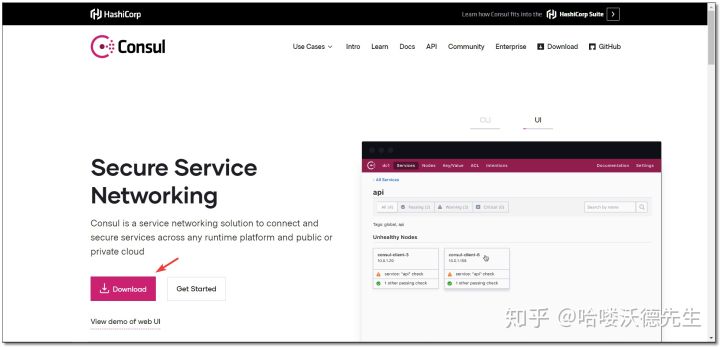
支持多种环境安装,截图中只显示了部分环境。
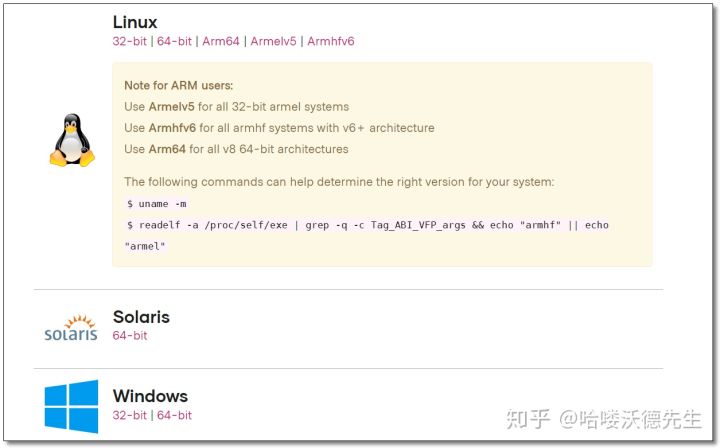
安装
单节点和集群的安装方式在之前的课程中已经详细讲解过,这里主要讲解 Consul 配置中心的作用,我们在 Windows 安装一个单节点的 Consul 即可。
下载后的压缩包中就只有一个 consul.exe 的执行文件。

cd 到对应的目录下,使用 cmd 启动 Consul
# -dev表示开发模式运行consul agent -dev -client=0.0.0.0
为了方便启动,也可以在 consul.exe 同级目录下创建一个脚本来启动,脚本内容如下:
consul agent -dev -client=0.0.0.0pause
访问管理后台:http://localhost:8500/ 看到下图意味着我们的 Consul 服务启动成功了。
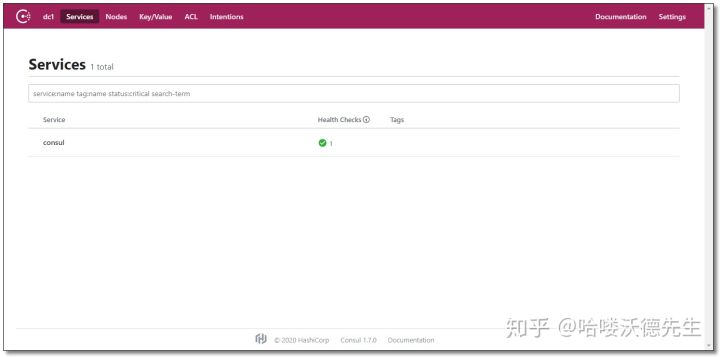
初始化配置
创建基本目录
使用 Consul 作为配置中心,第一步我们先创建目录,把配置信息存储至 Consul。
点击菜单 Key/Value 再点击 Create 按钮。

创建 config/ 基本目录,可以理解为配置文件所在的最外层文件夹。

创建应用目录
点击 config 进入文件夹。

再点击 Create 按钮。

创建 orderService/ 应用目录,存储对应微服务应用的 default 环境配置信息。

多环境应用目录
假设我们的项目有多环境:default、test、dev、prod,在 config 目录下创建多环境目录。
orderService文件夹对应default环境orderService-test文件夹对应test环境orderService-dev文件夹对应dev环境orderService-prod文件夹对应prod环境

初始化配置
以 dev 环境为例,点击 orderService-dev 进入文件夹。
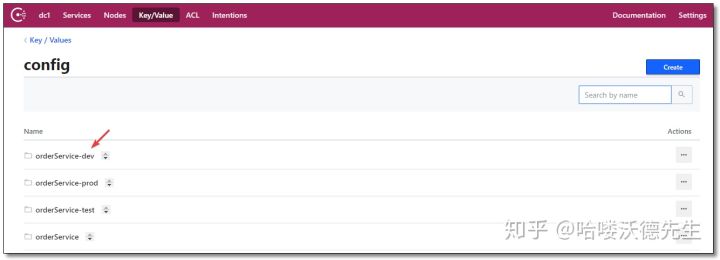
点击 Create 按钮准备创建 Key/Value 配置信息。

填写 Key:orderServiceConfig
填写 Value:
name: order-service-devmysql:host: localhostport: 3006username: rootpassword: root
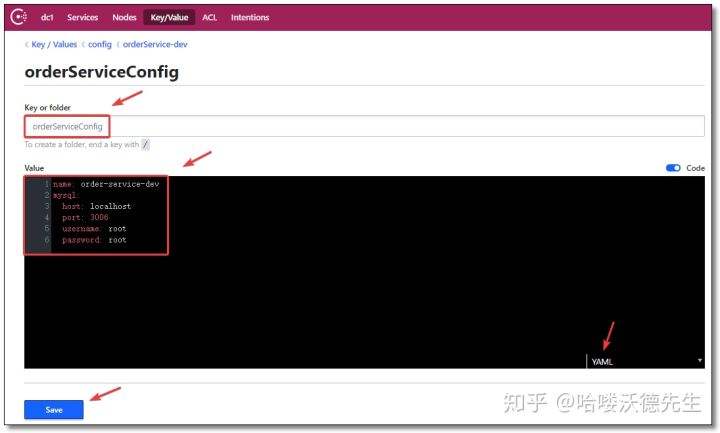
假设以上内容为订单微服务的配置信息,下面我们通过案例来加载 Consul 配置中心中的配置信息。
环境准备
consul-config-demo 聚合工程。SpringBoot 2.2.4.RELEASE、Spring Cloud Hoxton.SR1。
order-service:订单服务order-service02:订单服务
实践案例
添加依赖
需要从 Consul 获取配置信息的项目主要添加 spring-cloud-starter-consul-config 依赖,完整依赖如下:
order-service 和 order-service02 依赖一致。
<?xml version="1.0" encoding="UTF-8"?><project xmlns="http://maven.apache.org/POM/4.0.0" xmlns:xsi="http://www.w3.org/2001/XMLSchema-instance"xsi:schemaLocation="http://maven.apache.org/POM/4.0.0 http://maven.apache.org/xsd/maven-4.0.0.xsd"><modelVersion>4.0.0</modelVersion><groupId>com.example</groupId><artifactId>order-service</artifactId><version>1.0-SNAPSHOT</version><!-- 继承父依赖 --><parent><groupId>com.example</groupId><artifactId>consul-config-demo</artifactId><version>1.0-SNAPSHOT</version></parent><!-- 项目依赖 --><dependencies><!-- spring boot web 依赖 --><dependency><groupId>org.springframework.boot</groupId><artifactId>spring-boot-starter-web</artifactId></dependency><!-- spring boot actuator 依赖 --><dependency><groupId>org.springframework.boot</groupId><artifactId>spring-boot-starter-actuator</artifactId></dependency><!-- spring cloud consul discovery 服务发现依赖 --><dependency><groupId>org.springframework.cloud</groupId><artifactId>spring-cloud-starter-consul-discovery</artifactId></dependency><!-- spring cloud consul config 配置中心依赖 --><dependency><groupId>org.springframework.cloud</groupId><artifactId>spring-cloud-starter-consul-config</artifactId></dependency><!-- spring boot test 依赖 --><dependency><groupId>org.springframework.boot</groupId><artifactId>spring-boot-starter-test</artifactId><scope>test</scope><exclusions><exclusion><groupId>org.junit.vintage</groupId><artifactId>junit-vintage-engine</artifactId></exclusion></exclusions></dependency></dependencies></project>
配置文件
老规矩,配置文件必须叫 bootstrap.yml 我们除了使用 Consul 配置中心功能之外,把微服务也注册到 Consul 注册中心去。order-service 和 order-service02 的配置项中除了端口和注册实例 id 之外,其余配置项一致,完整配置如下:
server:port: 9090 # 端口spring:application:name: order-service # 应用名称profiles:active: dev # 指定环境,默认加载 default 环境cloud:consul:# Consul 服务器地址host: localhostport: 8500# 配置中心相关配置config:# 是否启用配置中心,默认值 true 开启enabled: true# 设置配置的基本文件夹,默认值 config 可以理解为配置文件所在的最外层文件夹prefix: config# 设置应用的文件夹名称,默认值 application 一般建议设置为微服务应用名称default-context: orderService# 配置环境分隔符,默认值 "," 和 default-context 配置项搭配# 例如应用 orderService 分别有环境 default、dev、test、prod# 只需在 config 文件夹下创建 orderService、orderService-dev、orderService-test、orderService-prod 文件夹即可profile-separator: '-'# 指定配置格式为 yamlformat: YAML# Consul 的 Key/Values 中的 Key,Value 对应整个配置文件data-key: orderServiceConfig# 以上配置可以理解为:加载 config/orderService/ 文件夹下 Key 为 orderServiceConfig 的 Value 对应的配置信息watch:# 是否开启自动刷新,默认值 true 开启enabled: true# 刷新频率,单位:毫秒,默认值 1000delay: 1000# 服务发现相关配置discovery:register: true # 是否需要注册instance-id: ${spring.application.name}-01 # 注册实例 id(必须唯一)service-name: ${spring.application.name} # 服务名称port: ${server.port} # 服务端口prefer-ip-address: true # 是否使用 ip 地址注册ip-address: ${spring.cloud.client.ip-address} # 服务请求 ip
配置文件实体类
order-service 和 order-service02 实体类代码一致。
package com.example.config;import org.springframework.boot.context.properties.ConfigurationProperties;import org.springframework.stereotype.Component;@Component@ConfigurationProperties(prefix = "mysql")public class MySQLProperties {private String host;private Integer port;private String username;private String password;public String getHost() {return host;}public void setHost(String host) {this.host = host;}public Integer getPort() {return port;}public void setPort(Integer port) {this.port = port;}public String getUsername() {return username;}public void setUsername(String username) {this.username = username;}public String getPassword() {return password;}public void setPassword(String password) {this.password = password;}}
控制层
order-service 和 order-service02 控制层代码一致。
注意需要添加 @RefreshScope 注解用于重新刷新作用域实现属性值自动刷新。
package com.example.controller;import com.example.config.MySQLProperties;import org.springframework.beans.factory.annotation.Autowired;import org.springframework.beans.factory.annotation.Value;import org.springframework.cloud.context.config.annotation.RefreshScope;import org.springframework.web.bind.annotation.GetMapping;import org.springframework.web.bind.annotation.RestController;@RefreshScope@RestControllerpublic class ConfigController {@Autowiredprivate MySQLProperties mySQLProperties;@Value("${name}")private String name;@GetMapping("/name")public String getName() {return name;}@GetMapping("/mysql")public MySQLProperties getMySQLProperties() {return mySQLProperties;}}
启动类
order-service 和 order-service02 启动类代码一致。
package com.example;import org.springframework.boot.SpringApplication;import org.springframework.boot.autoconfigure.SpringBootApplication;@SpringBootApplicationpublic class OrderServiceApplication {public static void main(String[] args) {SpringApplication.run(OrderServiceApplication.class, args);}}
测试
修改配置信息前
访问:http://localhost:9090/name 结果如下:

访问:http://localhost:9090/mysql 结果如下:
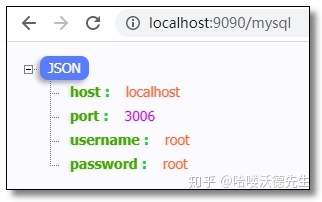
修改配置信息
修改 Consul 配置中心 orderService-dev 环境的配置信息为:
name: order-service-dev-2.0mysql:host: localhostport: 3006username: root123password: root123
修改配置信息后
控制台打印信息如下:
[TaskScheduler-1] b.c.PropertySourceBootstrapConfiguration : Located property source: [BootstrapPropertySource {name='bootstrapProperties-config/order-service-dev/'}, BootstrapPropertySource {name='bootstrapProperties-config/order-service/'}, BootstrapPropertySource {name='bootstrapProperties-config/orderService-dev/'}, BootstrapPropertySource {name='bootstrapProperties-config/orderService/'}][TaskScheduler-1] o.s.boot.SpringApplication : The following profiles are active: dev[TaskScheduler-1] o.s.boot.SpringApplication : Started application in 3.748 seconds (JVM running for 142.28)[TaskScheduler-1] o.s.c.e.event.RefreshEventListener : Refresh keys changed: [name, mysql.password, mysql.username]
Consul 使用 Spring 定时任务 Spring TaskScheduler来监听配置文件的更新。
默认情况下,它是一个定时任务线程池 ThreadPoolTaskScheduler,其poolSize值为 1。要更改TaskScheduler,请创建一个 TaskScheduler 使用 ConsulConfigAutoConfiguration.CONFIG_WATCH_TASK_SCHEDULER_NAME 常量命名的 bean 类型。
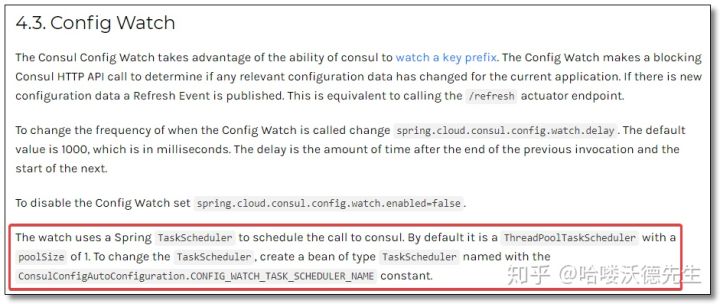
访问:http://localhost:9090/name 结果如下:

访问:http://localhost:9090/mysql 结果如下:
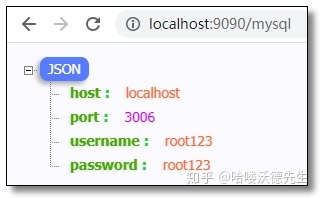
总结
HashiCorp 公司的 Consul 可谓是一款全能组件。可用于提供服务发现和服务配置的工具。用 go 语言开发,具有很好的可移植性,被 Spring Cloud 纳入其中。
在注册中心方面,Netflix Eureka 停止新版本开发,Consul 成为了优秀的可替代方案。
在配置中心方面,Consul 亦可替代 Spring Cloud Config 作为配置中心使用,且无需配合 Git、SVN 等工具,无需配合 Bus 消息总线即可实现集群配置更新。

